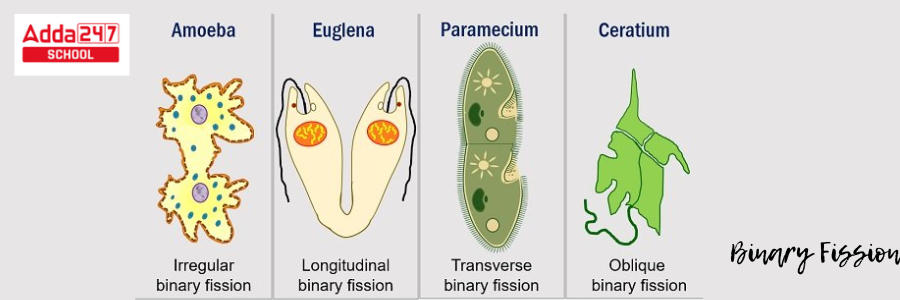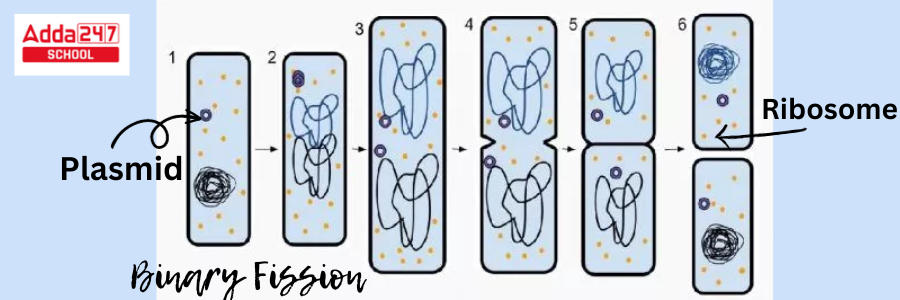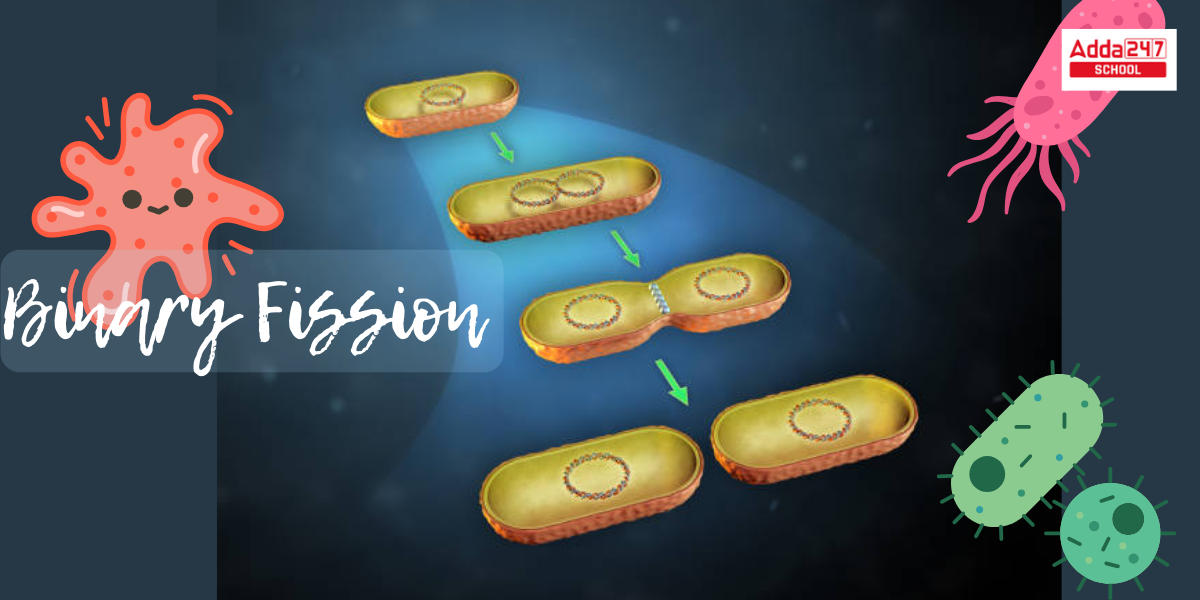Table of Contents
Binary Fission: Asexual reproduction in bacteria is accomplished through binary fission. Binary fission is conceptually identical to mitosis, which occurs in multicellular organisms (including mammals and plants), but its purpose is unique. Because binary fission is not associated with reproducing organelles or complicated chromosomes, it is a simpler process than mitosis. The mother cell divides into two new daughter cells in this type of Asexual Reproduction. The division and doubling of the parent’s genetic substance into two portions occurs during this procedure. Each daughter cell obtains one copy of its parental DNA here.
Binary Fission
A single organism splits into two separate species during binary fission. In eukaryotes, binary fission also defines organelle duplication. Mitochondria and other organelles must multiply by binary fission prior to mitosis, ensuring that each cell has an abundance of organelles. Binary fission occurs in the absence of the establishment of a spindle machinery in the cell.
The single DNA molecule initiates replication and then connects each duplicate to different sections of the cell membrane. The original and replicated chromosomes separate as the cell is dragged apart. However, this process has its disadvantages, As All of the resulting cells are genetically alike, mirror images of one another and the parent cell. This is how most antibiotics operate. If a parent cell is susceptible to an antibiotic, then all daughter cells are as well.
Check out, Amoeba: Cell, Diagram, Classification, Nutrition
Binary Fission Examples
Binary fission is a form of asexual reproduction that is most common among prokaryotes and a few unicellular eukaryotes. In prokaryotes, binary fission is the major mode of reproduction. Binary fission occurs in the absence of the establishment of a spindle machinery in the cell. The single DNA molecule initiates replication and then connects each duplicate to different sections of the cell membrane. The original (real) and replicated chromosomes separate as the cell is dragged apart. Here are some instances of Binary Fission organisms.
- Prokaryotes – bacteria, archaea, and cyanobacteria
- Eukaryotes – amoeba and Paramecium
- cell organelles – mitochondria
Binary Fission Types
Binary fission can be classified into four forms based on how the cells divide.
- Irregular binary fission: Cytoplasm can divide in any direction, but it is always perpendicular to the plane of chromosome division. Amoeba is an example.
- Transverse Binary fission: cytoplasm division occurs along the transverse axis. Paramecium is one example.
- Longitudinal Binary fission: cytoplasm division occurs along the longitudinal axis. Euglena is an example.
- Oblique Binary fission: Cytoplasm is divided in an oblique manner. Ceratium is an example.

Also Read, Paramecium Diagram, kingdom, Classification, Structure
Binary Fission Diagram
The Binary Fission diagram represents the gradual duplication of DNA material in a bacterial cell.

Steps in Binary Fission
A reproducing bacterium, like a human cell, requires DNA replication. In contrast to human cells, which have numerous linear (rod-like) chromosomes wrapped in a membrane-bound Nucleus, bacterial cells typically have a single circular chromosome and never have a nucleus. The bacterial chromosome, on the other hand, is found in a specialized area of the cell called the nucleoid. The process of duplicating DNA is described in detail here.
Step 1: A prokaryote’s DNA is tightly wrapped before binary fission, as shown in the above graphic. tiny plasmids, which are tiny rings of DNA that contain additional genetic information, are sometimes carried by prokaryotes.
Step 2: The DNA is unraveled during this stage of binary fission. As the ring of DNA unravels, specialized proteins get access to it and work to copy it. The same proteins function on the cell’s plasmids, cloning them as well.
Step 3: The DNA and plasmids have both been replicated. Individual sets of DNA attach to various sections of the cell membrane. The DNA molecules are dragged to various sides of the cell when the cell expands in preparation for division.
Step 4: A cleavage furrow emerges in the cell membrane when the cell wall and membrane begin to pinch off, which causes the formation of two new cells.
Step 5: Finally, as a new bacterial cell wall forms, the cells become entirely isolated from each other. The final step is to eliminate any remaining proteins or additional molecules that connect the two cells.
Step 6: Each of the two cells now has whatever it requires to carry out life’s tasks on its own.
Binary Fission vs Mitosis
Bacterial binary fission is very similar to mitosis in humans and other eukaryotes in several aspects. Let us compare the Binary fission and mitosis –
- Chromosomes are replicated and segregated in both circumstances, and the cell partitions its cytoplasm to generate two new cells.
- The principles of operation and sequence of the two operations, however, are quite different. For one thing, bacteria do not create mitotic spindles.
- Fission of binary atoms Not entirely dependable. Sometimes daughter cells have an uneven number of chromosomes. Mitosis, on the other hand, is far more trustworthy because the chromosomal number stays the same throughout the process.
- Perhaps more critically, DNA replication occurs concurrently with the separation of DNA during binary fission, unlike mitosis, where DNA is copied during the S phase and separated in the M phase.
Binary Fission in Bacteria
Bacteria reproduce asexually through a process known as binary fission. Bacteria are thought to be one of the earth’s earliest forms of life. Bacteria are unicellular creatures of the prokaryotic kingdom. A few organelles and a real nucleus are missing from these creatures. In bacteria, the following processes are involved in binary fission:
Step 1: DNA replication -The bacterium unravels and repeats its chromosome, thereby doubling its size.
Step 2: Cell Development – The bacterium begins to grow larger after copying the chromosome in preparation for binary fissions. Following that, the cytoplasmic content increases. Another distinguishing feature of this stage is that the two strands move to the cell’s opposite poles.
Step 3: DNA Segregation- The cell expands and a septum forms in the center. In this step, the two chromosomes are also separated.
Step 4: Cell Division – At this stage, a new cell wall is created, and the cell divides at the center, separating the parent cell into two separate daughters. As required organelles, each daughter cell has an exact duplicate of the nuclear materials.
Binary Fission in Amoeba
Amoebae reproduce by binary fission. It is a unicellular eukaryotic creature. The cell splits into two equal-sized daughter cells after reproducing its genetic material via mitotic division. Amoeba is a member of the protozoa kingdom. They are anaerobic, unlike eukaryotic species, because amoeba lacks mitochondria and generates ATP solely through anaerobic methods.
Binary fission of Amoeba
Binary fission happens when conditions are favorable, such as when there is adequate food, water, and an appropriate temperature. let’s understand the binary fission process step by step below.
Step 1: The genetic material in the nucleus of amoeba replicates during mitotic division during binary fission. By the technique of karyokinesis, the nucleus initially divides into two daughter nuclei.
STEP 2: After that, cytokinesis occurs, in which the parent amoeba’s cytoplasm separates into two daughter cells. Each of the two daughter cells has its own nucleus and cell organelles.
STEP 3: Amoeba binary fission is inconsistent because cytokinesis can occur along any plane but is always parallel to the plane of karyokinesis.
STEP 4: The cell creates proteins and nutrients during cytokinesis.
Multiple Fission of Amoeba
Amoeba is able to reproduce by multiple fissions as well. In multiple fissions, one parent amoeba multiplies to produce a large number of daughter cells in an unfavorable environment.
If an Amoeba segment is cut into two halves. The segment with the nucleus would recover and function normally, whereas the section without the nucleus would perish.
Advantages of Binary Fission
The following are the benefits of binary fission:
- The reproduction rate is high since the method of binary fission is exceedingly fast.
- For reproduction to occur, just one organism is required, rather than two mating partners.
- It is a quick process whose exact speed is determined by various growth characteristics such as nutrient availability, humidity, temperature, population, and quantity of organisms.
Disadvantages of Binary Fission
The drawbacks of binary fission are covered in this section.
- As there is no variety in reproduction, all cells are similar and have the same genetic information.
- Lacking the capacity for adaptation, increasing the organism’s chances of extinction



 CBSE Board Result 2025 Date Soon at resu...
CBSE Board Result 2025 Date Soon at resu...
 NEET MDS Admit Card 2025 (OUT) Today at ...
NEET MDS Admit Card 2025 (OUT) Today at ...
 UP, MP, CBSE Board Result 2025 Live Upda...
UP, MP, CBSE Board Result 2025 Live Upda...










